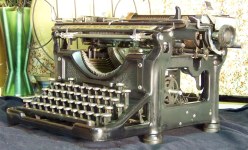Christine DeSmet, guest blogging recently at the Blackbird Writers’ website, raised the topic of typing.
Not keyboarding. Typing.
Touch Typing
Way back in the twentieth century, every high school taught “touch typing,” with students achieving speeds of sixty words or more per minute, error-free, on manual typewriters. Nearly all typing students were young women, because typing was a secretarial skill.

The crewcut lads who hung around the malt shop after school, you see, would become executives and have secretaries to do their typing; the girls would be those secretaries.

Yes, Dear Reader, of course we understand that not all boys became executives. But those who did not would become farmers or mechanics or shopkeepers and would have no need for typing. Only large businesses and government departments could possibly need their writing to look like printing. Ordinary folks could, and mostly did, get by with cursive scrawls in pen or pencil, as long as the numerals were legible.
Today, all children, male and female, learn “keyboard skills” at a young age. The process by which they learn these skills is a mystery, but it seems to involve thumbs and cell phones.
Manual Typewriters
When I was growing up—and even when Christine DeSmet, who is much younger, was growing up—there was no word-processing. There was no spell-check.
Nothing was virtual. Everything was real. Every tap on a key was answered by the whack of a steel typebar planting its face in an inked ribbon to strike a letter onto the paper beyond.
If you made a typographic error you had to manually remove it from the paper by one of three or four clever methods—none of them quite satisfactory. Important documents had to be perfect ab initio: one errant keystroke and you started over from the top.

The mere act of typing strengthened your fingers, because you needed to hit the keys with strong and uniform force.
As a young man, I did not take a touch typing course in high school. Fortunately for me, my mother taught me the rudiments on our old Underwood machine. Thus I gained skill enough to type term papers in college, where, by the early 1960s, typed papers had become the required standard.
Military Typing
Later, the United States Air Force improved me. I was sent to the Defense Language Institute in Monterey, California, to learn Mandarin Chinese; then on to San Angelo, Texas, to learn radio eavesdropping techniques. The Air Force gave me a class to bring my typing speed from about 20 WPM up to 35. This standard achieved, they sent me out into the world of international espionage.

From a windowless compound surrounded by tea fields on a Taiwan mountaintop, we listened in on Chinese Air Force pilots and controllers across the straits. We made sketchy intercept notes in real time but went back later, listened to our tapes, and transcribed all that traffic in verbatim English translations, banging away on manual typewriters. The clunky old Royal of those days, purchased in thousands by Uncle Sam, was a nearly indestructible machine. I ought to know; I tried hard.

The transcripts we made of Chinese military air traffic ultimately went into a huge, room-occupying computer at the National Security Agency in Maryland. How they got there I never learned. But at some point, they must have been manually re-keyed for electronic entry into the Big Daddy Computer.
Therefore, our typing did not have to be perfect. If you made a mistake, you just struck over it. As long as the person typing the traffic into the computer could make out what you had meant to type, it was good enough.
I still type about 35 words per minute. I still make lots of mistakes, but on a modern laptop it’s not that big a deal. Corrections are easy.
Kids today have no idea.
Blessings,
Larry F. Sommers, Your New Favorite Writer

Author of Price of Passage—A Tale of Immigration and Liberation.
Price of Passage
Norwegian Farmers and Fugitive Slaves in Pre-Civil War Illinois
(History is not what you thought!)

